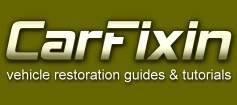|
|
 |
Paintless Paint Scratch Repair Tutorial
Quarter Panel
|
Here we have a scratch in the paint which in a common area of the vehicle, the quater panel. It is about 3 to 4 inches long. This tutorial will show you how to permenantly remove this scratch. When determining whether a scratch is too deep to buff out, slide your fingernail lightly across the width of the scratch, if your fingernail catches the edge (edge=depth here), the scratch probably isn't going to completely "go away", so a few things can happen here depending on the depth of the scratch. If the edge cannot be felt, buffing will totally eliminate the scratch. If the edge can "barely" be felt, chances are buffing will eliminate it enough to "barely" be seen. If the edge is significant, say like in key scratch, then it is too deep to buff out, but do not fear, we have included other tutorials on fixing or touching up scratches. |
Materials needed:
| • | 1000 or 1500 grit wet/dry sandpaper |
| • | Cutting compound |
| • | Finishing compound |
| • | High speed buffer with two pads. A wool pad used with cutting compound and a foam pad used with finishing compound. |
| • | Extension cord |
| • | Spray bottle filled with water |
| • | Clean rag or terry cloth towel |
| • | Soft sanding block |
| • | Latex gloves and clear eye protection for safety | |
|
It is best if the panel to be buffed is not super hot, so if the vehilce has been in the sun for several hours, if possible, move the vehicle to your garage, shaded or covered area for best results. Wipe the area clean. wrap the sanding block with the sandpaper. Using the spray bottle saturate the scratch and the sandpaper with water. Start sanding scratch using a light touch allowing the sandpaper to do the work making sure the sanding block is flush with the vehicles surface keeping everything wet as you sand. Do not exert extreme pressure. Sand briefly back and forth and wipe dry as you go and feel for the scratch. You are done when the scratch feels smooth. Keep in mind there is a fine line here where one can sand or burn through the paint, so sand lightly and very briefly back and forth 6-10 times, then wipe and check, repeat this process as necessary. |
|
Keep everything wet as you sand. Sand briefly
and wipe dry as you go, and feel for the scratch. You are done when the scratch feels smooth. |
|
When done sanding, wipe the area completely dry. The surface will look dull due to the sand scratches. |
|
The surface will look dull after sanding. |
|
Here we are using a spur designed to remove dry compound from the wool pad which accumulates from previous uses. Eliminate this step if you are using a new pad. |
|
Apply cutting compound to the surface. |
|
Tip: To eliminate compound flying all over and making a mess, start the buffer then release trigger while pad is in motion and spread compound over the working area. Idea here is to have buffer wheel in motion and lightly spreading the compound before exerting the necessary pressure. Move the buffer over the compound from left to right, then right to left, back and forth, up and down. Do this for say 20 second intervals, check the scratch and reapply compound in between as necessary. Letting the buffer stay in one single spot for too long and/or not using enough compound can burn through the clearcoat finish. Just keep the buffer moving and use your compound, and you will be fine. |
|
Keep the buffer moving up and down and from left to right. Don't continuously buff in one
spot or you will burn through the clear. Not good! |
|
This is the quarter panel after using the cutting compound. The sand scratches have been eliminated, but the area will
still appear somewhat dull. |
|
Put the foam pad on the buffer. No need to worry about using the spur on these even if it is not a new pad. |
|
Apply finishing compound to the panel. |
|
Buff in the same manner, remembering to keep the buffer moving at all times, back and forth, up and down. |
|
Reapply finishing compound in between buffing as you see fit. Usually twice is sufficient. Wipe panel with clean towel. |
Here is the finished quarter panel. The surface will look slick, feel smooth, and the scratch will be GONE!
~CarFixn~ |
 |
|
|
| |
Disclaimer: *All information on this site is provided "as is" without any warranty of any kind,
either expressed or implied, including
but not limited to fitness for a particular use.
Any user assumes the entire risk as to the accuracy and use of this information.
Copyright © 2008 CarFixin.com
- Today is Sunday, January 4, 2026 |





















